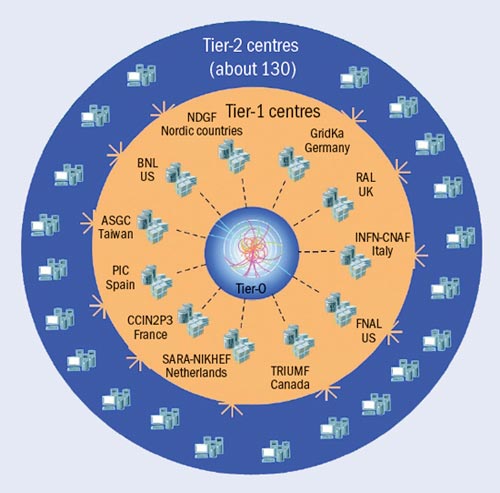Grid Computing
Grid Computing is
"The sharing that we are concerned with is not
primarily file exchange but rather direct access to
computers, software, data, and other resources, as is
required by a range of collaborative problem-solving
and resource-brokering strategies emerging in industry,
science, and engineering. This sharing is, necessarily,
highly controlled, with resource providers and
consumers defining clearly and carefully just what is
shared, who is allowed to share, and the conditions
under which sharing occurs. A set of individuals and/or
institutions defined by such sharing rules form what we
call a virtual organization."
(The Anatomy of the Grid, Intl J. Supercomputer
Applications, 2001; 15 (3), Ian Foster, Carl
Kesselman, Steven Tuecke)
HEP analysis
Analysis of High Energy Physics Data
The analysis of the data of HEP (high energy physics) experiments requires a sophisticated chain of data processing and data reduction. The data recorded by the experiment has to follow a chain of reconstruction and analysis programs before they are examined by the physicist. The stages can be characterized by their data format.

In the first stage raw data is
delivered by the data acquisition system of the
experiment. The data consists out of the raw
measurements of the detectors. These can be channel
numbers, time measurements,charge depositions and other
signals. Due to the large number of channels one can
expect a single event to have a size in the order of
several hundreds of kilobytes to several megabytes.
Integrated over the time of data taking during a year
the overall data size is expected to be in the order of
a petabyte. The data has to be recorded in a safe way
on permanent storage.
The data will then be processed in a complicated
reconstruction step. Raw numbers are converted into
physical parameters as space coordinates or calibrated
energy deposits. A further pattern recognition step is
translating these numbers in parameters of observed
particles, characterizing them by their moments or
their energy. The output of this processing step is
called reconstructed data. Its size is
typically in the same order as the raw data. Data in
that format has to be distributed to a limited number
of users for detector studies and some specific
analysis.
To simplify the analysis procedure only the most
relevant quantities are stored in separate streams.
These data is typically referred AOD
(Analysis Object Data). The size of the events is
significantly reduced and this format provides the
input for physics analysis. It is expected that the
amount of AOD for a year of data taking is in the order
of 100 TB.
In the process of the analysis of the data physicists
will often perform a further data reduction. Sometimes
skims for interesting events are performed. Often the
physicist define their own ad hoc data format. In ATLAS
these datasets are known as DPD
(Derived Physics Data), in CMS as PAT
Skims (Physics Analysis Toolkit).
Of special consideration are simulated event data, the
Monte Carlo events. In the process of
the analysis it is required to study carefully the
sensitivity and coverage of the detectors. The basis of
such studies are careful and detailed simulation of
event simulations.
Tier structure
The Organization of the Global Infrastructure
Already at an early stage it was recognized that analysis of data on the foreseen scale would require careful planning and organization. Different computing centres would have to have different roles according to their resources and their geographical location. The MONARC working group (Models Of Networked Analysis at Regional Centres) defined a tiered structure that groups computing centres according to their characteristics.

The Tier-0 is the computing centre
in CERN. As the site is hosting the experiments, its
computing centre has a special role. It is required
that all original data are recorded to permanent
storage. Then initial processing of the data has to be
performed on the site to provide rapid feedback to the
operation. The data is then sent to other computing
centres for analysis. It´s main role is to provide
analysis capacity for local users. Computing resources
for simulation can be provided to the experiments on an
opportunistic basis. Other resources are usually
reserved for local users.
A number of large computing centres (eleven in total)
take the role of Tier-1 centres for
the various computing centres. They receive data
directly from CERN and provide additional permanent
storage. The computing centres provide also the
computing resources for reprocessing of the data,
required at a later stage in the analysis. As major
facilities they have a special role also in providing
reliable services to the community as databases and
catalogues. The centres are also responsible for the
collection of simulated events produced at higher Tier
centres.
A large number of sites take the responsibility as
Tier-2 centres. Their role is to
provide the bulk of computing resources for simulation
and analysis. Typically they are associated with large
disk storage to provide temporary storage data that is
required for analysis. In total about hundred such
centres have been identified.
The model is complemented by a large number of smaller
computing centres at various universities and
laboratories, the Tier-3 centres.
Their main role is to provide analysis capacity for
local users. Computing resources for simulation can be
provided to the experiments on an opportunistic basis.
Other resources are usually reserved for local users.






